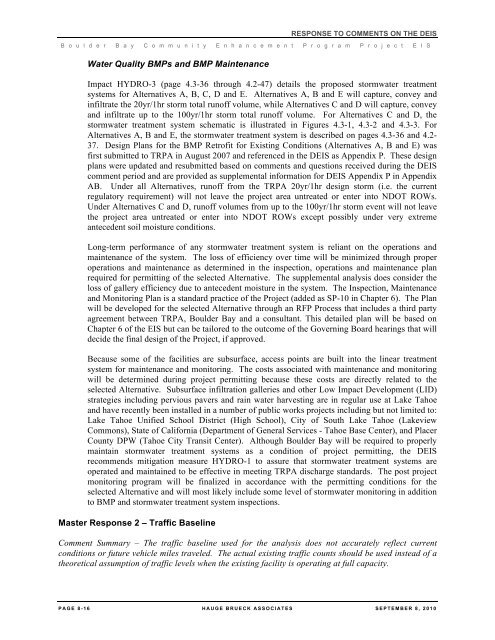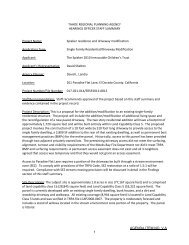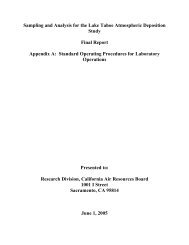FEIS - Tahoe Regional Planning Agency
FEIS - Tahoe Regional Planning Agency
FEIS - Tahoe Regional Planning Agency
Create successful ePaper yourself
Turn your PDF publications into a flip-book with our unique Google optimized e-Paper software.
RESPONSE TO COMMENTS ON THE DEIS<br />
B o u l d e r B a y C o m m u n i t y E n h a n c e m e n t P r o g r a m P r o j e c t E I S<br />
Water Quality BMPs and BMP Maintenance<br />
Impact HYDRO-3 (page 4.3-36 through 4.2-47) details the proposed stormwater treatment<br />
systems for Alternatives A, B, C, D and E. Alternatives A, B and E will capture, convey and<br />
infiltrate the 20yr/1hr storm total runoff volume, while Alternatives C and D will capture, convey<br />
and infiltrate up to the 100yr/1hr storm total runoff volume. For Alternatives C and D, the<br />
stormwater treatment system schematic is illustrated in Figures 4.3-1, 4.3-2 and 4.3-3. For<br />
Alternatives A, B and E, the stormwater treatment system is described on pages 4.3-36 and 4.2-<br />
37. Design Plans for the BMP Retrofit for Existing Conditions (Alternatives A, B and E) was<br />
first submitted to TRPA in August 2007 and referenced in the DEIS as Appendix P. These design<br />
plans were updated and resubmitted based on comments and questions received during the DEIS<br />
comment period and are provided as supplemental information for DEIS Appendix P in Appendix<br />
AB. Under all Alternatives, runoff from the TRPA 20yr/1hr design storm (i.e. the current<br />
regulatory requirement) will not leave the project area untreated or enter into NDOT ROWs.<br />
Under Alternatives C and D, runoff volumes from up to the 100yr/1hr storm event will not leave<br />
the project area untreated or enter into NDOT ROWs except possibly under very extreme<br />
antecedent soil moisture conditions.<br />
Long-term performance of any stormwater treatment system is reliant on the operations and<br />
maintenance of the system. The loss of efficiency over time will be minimized through proper<br />
operations and maintenance as determined in the inspection, operations and maintenance plan<br />
required for permitting of the selected Alternative. The supplemental analysis does consider the<br />
loss of gallery efficiency due to antecedent moisture in the system. The Inspection, Maintenance<br />
and Monitoring Plan is a standard practice of the Project (added as SP-10 in Chapter 6). The Plan<br />
will be developed for the selected Alternative through an RFP Process that includes a third party<br />
agreement between TRPA, Boulder Bay and a consultant. This detailed plan will be based on<br />
Chapter 6 of the EIS but can be tailored to the outcome of the Governing Board hearings that will<br />
decide the final design of the Project, if approved.<br />
Because some of the facilities are subsurface, access points are built into the linear treatment<br />
system for maintenance and monitoring. The costs associated with maintenance and monitoring<br />
will be determined during project permitting because these costs are directly related to the<br />
selected Alternative. Subsurface infiltration galleries and other Low Impact Development (LID)<br />
strategies including pervious pavers and rain water harvesting are in regular use at Lake <strong>Tahoe</strong><br />
and have recently been installed in a number of public works projects including but not limited to:<br />
Lake <strong>Tahoe</strong> Unified School District (High School), City of South Lake <strong>Tahoe</strong> (Lakeview<br />
Commons), State of California (Department of General Services - <strong>Tahoe</strong> Base Center), and Placer<br />
County DPW (<strong>Tahoe</strong> City Transit Center). Although Boulder Bay will be required to properly<br />
maintain stormwater treatment systems as a condition of project permitting, the DEIS<br />
recommends mitigation measure HYDRO-1 to assure that stormwater treatment systems are<br />
operated and maintained to be effective in meeting TRPA discharge standards. The post project<br />
monitoring program will be finalized in accordance with the permitting conditions for the<br />
selected Alternative and will most likely include some level of stormwater monitoring in addition<br />
to BMP and stormwater treatment system inspections.<br />
Master Response 2 – Traffic Baseline<br />
Comment Summary – The traffic baseline used for the analysis does not accurately reflect current<br />
conditions or future vehicle miles traveled. The actual existing traffic counts should be used instead of a<br />
theoretical assumption of traffic levels when the existing facility is operating at full capacity.<br />
PAGE 8- 16 HAUGE BRUECK ASSOCIATES SEPTEMBER 8 , 2010






